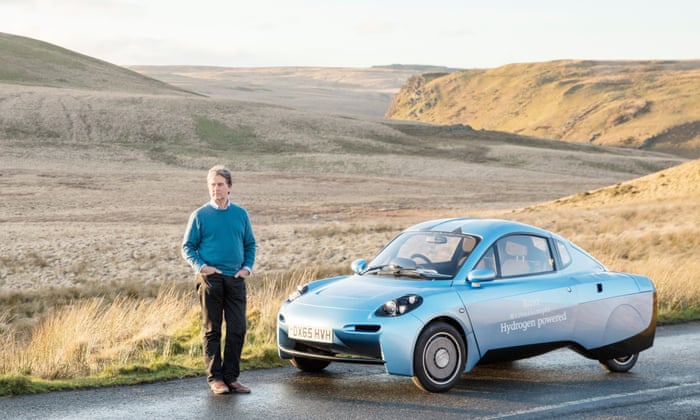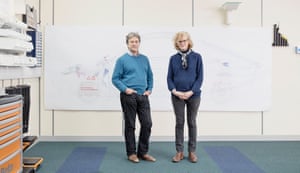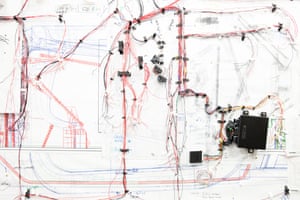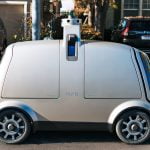
Inventor Hugo Spowers has a dream: to replace today’s cars with his own hydrogen prototype. Is the world ready?
In the mid-1990s, Hugo Spowers ran a Formula Three racing team. At the time, motorsport was in the pocket of big tobacco. Every weekend, Formula One cars emblazoned with cigarette brands – Marlboro, Camel, Silk Cut – raced on TV in front of millions. “It was pretty clear it was killing people,” Spowers says. “Meanwhile, the industry was portraying a link between smoking and winners. It was ludicrous. But nobody was going against it.”
So when, in 1995, Spowers’ team introduced a car decorated with an anti-smoking campaign, it caused a commotion. At a party the night before the car was set to debut at the British Grand Prix, the chairman of the British Racing Drivers’ Club summoned Spowers, outraged. “He bellowed at me for a full five minutes, about how motorsport needed its sponsors, and ‘not pinkos like you’,” Spowers says now, chuckling. But Spowers was unmoved: he knew he was right. Furthermore, he believed it made financial sense: the relationship with tobacco was tainting the sport for businesses that didn’t want to be associated with smoking.
But industries are slow to change, and Spowers’ scheme found few backers. Disillusioned and low on funds, he quit racing soon after. It wasn’t until 2006 that motorsport finally banned tobacco advertising completely.
So Spowers is used to being doubted, mocked and shouted down. But he has also learned to be patient. Sometimes, the only way to tell the difference between a crackpot and a visionary is to wait a while.
Now 57, Spowers has the grey hair of an ageing rock star, a ruddy complexion and a dishevelled charm. When we meet, a checked shirt is poking through large holes in his red cable-knit jumper; his trousers are being held up by a belt made from an upcycled fire hose. For the last 16 years, Spowers has been founder and chief engineer of Riversimple, a small hydrogen-fuelled car company based in Llandrindod Wells, in mid-Wales. In 2016, it unveiled its first production-ready car: the Rasa, a radical, ultra-light two-seater powered by a hydrogen fuel cell. This year, the company will roll out a beta test of 20 cars in Monmouthshire and if all goes well, Spowers hopes to have the car on the market in 2019. “As far as we can tell,” he says, “we are the only independent hydrogen car startup in the world.”
***
Riversimple’s headquarters lie on a small industrial park in otherwise picturesque Welsh countryside: the surrounding hills are flocked with sheep; the main office overlooks a stream. Inside, engineers work at desks upcycled from pallets. Spowers employs 19 people, and today several engineers in the workshop are huddled around the chassis of the first of Rasa’s beta test cars. This has just arrived from the supplier in Melton Mowbray (Riverside tries to use UK-based suppliers where possible) and is undergoing testing before the other 19 are ordered.
The Rasa (short for tabula rasa, or clean slate) is baby blue and has a sleek, friendly design. Its unusual, aerodynamic shape was designed by Chris Reitz, who also designed the modern Fiat 500. “We want to design something people want, not just for eco guilt,” Spowers says. The entire car weighs just 580kg, or less than half a Volkswagen Golf and a quarter of a Tesla Model S.
Its chassis is carbon fibre, and it uses low-rolling resistance wheels. Every part has been painstakingly engineered for lightness; the lower the weight, the less energy required. The car can do 0-60mph in 10 seconds – the equivalent of a Ford Fiesta – and has a range of around 300 miles. But it does that on just 1.5kg of hydrogen, using a tiny 8.5kW fuel cell. Toyota’s hydrogen car, the Mirai, uses 5kg to achieve the same range.

The fuel cell is supplemented by a bank of supercapacitors – extremely fast-charging batteries – that supply four wheel-mounted electric motors with additional power for acceleration. An innovative regenerative braking system captures most of the energy wasted during braking, putting it back into the supercapacitors. When combined with the fuel cell, Spowers says, that lets the Rasa achieve the equivalent of more than 250 miles per gallon. Running on hydrogen from renewable sources, that would make it a contender for the most sustainable car in the world.
The engineers roll the Rasa out into the car park, and Spowers offers to take me for a drive. Its gull-wing doors swing open to reveal a sparse if surprisingly spacious cabin. “All strapped in OK?” He flicks a series of switches; the fuel cell and air compressor burble into life, creating a great whooshing noise. It feels like sitting in a DeLorean.
This car is clearly a prototype – there’s no heating and the dashboard’s LCD screen isn’t working (Spowers says these issues will be fixed in the beta cars) – but it’s surprisingly polished. We whiz out of Riversimple’s lot. Spowers is in his element; back when he ran his Formula Three team, he’d race a little, too, and he drives fast, with the practised economy of a semi-professional. That’s the other selling point: “It’s awfully good fun,” he says, grinning.
For years, Riversimple was just Spowers and an idea. The family was supported by Hugo’s wife Fiona, then in a senior role at advertising agency TBWA (they have a 17-year-old son, Stirling, named after Stirling Moss, and a daughter, Djazia, 15). These days, Fiona is a director at Riversimple; she has curly blond hair, rectangular glasses and a calm, concise demeanour, a natural counterweight to Spowers’ academic enthusiasm.
The first car that Riversimple built was the LIFECar, a collaboration with the classic carmaker Morgan. When the LIFECar debuted at the Geneva Motor Show in 2008, it was heralded as a breakthrough: it could hit 90mph and weighed just 650kg. “It was to demonstrate, in 2007, that a zero-emissions sports car was possible,” recalls Charles Morgan, then managing director of the carmaker. But the company deemed it too expensive to continue. “Breakthroughs are never easy,” Morgan says.
Riversimple then adapted the LIFECar technology into a small, low-cost, Smart car-like prototype called the Hyrban. Plans were floated for a consumer trial in Leicester, but the project failed to secure funding and political approval. “At the same time, the crash happened, and that took an enormous amount of courage out of all investors,” Fiona tells me over lunch in Riversimple’s boardroom. “The appetite for radical ideas evaporated.”
I ask why they never gave up on the idea. “From time to time, we are in the doldrums, but not for long,” Fiona says. “There is always momentum and progress.”
“We haven’t actually got to the point of mortgaging the house,” Hugo says.
“Yes, we have.” Fiona turns her head, exasperated. “What do you mean?”
“Oh, yes,” Hugo says, sheepishly. “Yes, yes, yes, we have, yes.”
In 2015, Riversimple reached a breakthrough: the company was awarded a £2m grant by the Welsh government to develop the Rasa. This was followed by a €2m grant from the EU for the beta test. Then, in June 2016, the UK voted to leave the European Union.
Spowers is nervous about what Brexit means for the company. “Those EU grants will disappear, and also the EIB [European Investment Bank].” At a recent conference, he met an EIB representative who confirmed his fears about future funding for UK projects. “He said the sense there is that, if the telephone rings and it starts with a 44, don’t bother picking up.”
***
The car industry has been slow to kick its fossil-fuel habit: electric vehicles (EVs) still make up less than 2% of all new cars sold. But that is expected to change rapidly: in 2017, the UK and France announced their intention to ban the sale of new petrol and diesel cars by 2040. Germany and China are expected to follow suit. All Volvos will be electric or hybrid from 2019. Every major manufacturer is investing heavily in the development of electric cars such as the Tesla Model 3and Nissan Leaf, which run on lithium-ion batteries.
For a long time, the industry has explored another alternative to the combustion engine: hydrogen fuel cells. To put it simply, fuel cells work by electrochemically combining hydrogen, stored in a pressurised tank, with air to generate an electric current; the only emission is water vapour. However, development of fuel cell technology has been slow. They are expensive to produce (platinum is a key component), as is hydrogen. The gas is flammable and difficult to store. And while hydrogen can be produced using renewable energy via electrolysis (using a current to separate water into hydrogen and oxygen) it’s more commonly produced from natural gas, releasing carbon dioxide in the process. For that reason, Tesla’s Elon Musk has called the technology “fool cells”. There’s an industry joke: hydrogen is the fuel of the future – and it always will be.
A longstanding defence made by hydrogen advocates is that it is more practical. Hydrogen cars can travel more than 300 miles on a single tank and refuel in minutes, similar to refuelling a petrol car, whereas today’s EVs take several hours to charge.

“It takes five minutes to fill a car with petrol. A Tesla is 30 minutes with a supercharger, and that’s to 80% [charged],” Spowers says. “So for a motorway services with 20 petrol pumps, you’d need to replace them with 120 chargers to get the same throughput of cars. Each Tesla charger is 120kW, so that means you’d need a 14.4mW substation – the equivalent of powering 32,000 homes in the UK. Charging one battery car is very easy; filling one hydrogen car is impossible. But as you scale, that situation completely reverses.”
As batteries and hydrogen gas simply store energy, they don’t in themselves reduce carbon emissions – rather, they move the emissions problem on to the electricity grid: the energy still has to be produced somewhere. Which is fine in places such as California, where home solar panels are practical year round, but less so in countries where the grid runs on dirty coal and natural gas. Add in the emissions of making the battery and, according to some academic studies, an electric car actually emits more CO2 over its lifespan than an efficient petrol vehicle.
Solar and wind power are intermittent, which is why governments are piling money into grid storage technologies. Therein may lie hydrogen’s advantage: it can be produced using excess renewables energy at peak time, then stored in tanks or underground caverns. Moreover, because hydrogen emits no carbon when burned, it can be used to supplement or replace natural gas (methane) in heating homes and businesses – responsible for nearly a third of the UK’s carbon emissions. To date, that has been considered too expensive. But so, too, will be the process of upgrading the electricity grid to deal with electric cars.
At the 2017 World Economic Forum in Davos, a consortium of companies including Toyota, Honda, Daimler, Shell and BMW announced the formation of the Hydrogen Council, which will invest in hydrogen research and lobbying. Japan has announced its intention to become the world’s first “hydrogen society”, aiming to have 35 hydrogen fuel stations in operation by 2020.
Toyota, whose Prius popularised the hybrid car, is betting heavily on hydrogen, with a £65,000 consumer sedan called the Mirai, fuel-cell buses and trucks in development. “As a storage medium, it’s really quite interesting,” says Jon Hunt, who works for Toyota’s hydrogen business. “You can ship it in the gas grid network, you can burn it in a domestic boiler, you can use it in processes like fuel cells.” Toyota expects 30% of vehicles to be hydrogen powered by 2050.
But Spowers’ real criticism of battery-electric cars is much simpler: it’s that they are too heavy. “The top of the range Tesla has a battery heavier than our car,” he says. He’s not against batteries; he’s just as critical of manufacturers trying to put hydrogen into existing cars. “That’s why it’s so expensive, because you’re trying to put it into conventional cars. Whereas if you design a car around the characteristics of hydrogen, you can essentially work around those barriers and they all disappear.”
***
Hugo Spowers had a privileged upbringing. His father, William, an Australian, established the books department at Christie’s auction house and was an avid horticulturalist, establishing one of the country’s largest private arboretums. Spowers credits his environmentalism to weekends working in the gardens. “I grew up wanting to make wildlife documentaries,” he says. “Then, at 15, I caught the motor racing bug.” After Eton, he studied engineering science at Oxford, and fell in with the Dangerous Sports Club, a society that became notorious for staging extreme and surreal stunts. The group is credited with inventing zorbing and bungee jumping; Spowers claims to be the first ever to jump head first.
After university, he got a job as a mechanic working on racing cars. He became intimately familiar with car design: the difference between brackets made in Britain and Italy; the benefits of lightness. His first car was a Pelland, a rare kit car with a fibreglass body. “It was incredibly lightweight. I could pick the front end up in a tight parking space and move it,” he says. In 1982, he and some colleagues built a car “on three and sixpence” and entered it into the Le Mans 24 Hours. Soon after, he founded Prowess Racing and entered Formula Three.
When Spowers quit motorsport, he considered leaving the car industry altogether. He immersed himself in the writings of leading ecologists (Amory Lovins, Paul Hawken) and became interested in the study of complex systems. In 1996, he enrolled in a residential course Hawken was teaching at Schumacher College in Totnes, Devon. During an extracurricular weekend rock-climbing trip, Hawken – whose book The Ecology Of Commerce Spowers credits as a major influence – convinced him of the potential of fuel cells.
Spowers studied for an MBA (his thesis was on the feasibility of fuel cell cars) and came to a dramatic conclusion: that in order for the car industry to be sustainable, it’s not just a question of hydrogen or batteries – it needs an entirely different business model.

Traditional car companies – in fact, traditional corporations, period – Spowers says, will never solve our environmental problems. Publicly listed companies are driven by shareholder returns, shareholder returns by profits, and profits by selling as many goods as possible – and, therefore, using up as many natural resources as possible. “Your interest is maximising resource consumption. That’s what maximises your profit.”
So rather than sell Rasas, Riversimple plans to lease them to drivers, charging a fixed tariff and mileage fee. They don’t have an exact price for the consumer version – it will depend on hydrogen prices at the time, but will definitely be less than £500 a month all-inclusive (including fuel and insurance). Their target is the same monthly running cost as a VW Golf. “We’re the only car company in the world that never wants to sell a car,” Spowers says.
The leasing model makes the Rasa’s expensive carbon-fibre chassis cost-effective, because it increases the car’s lifespan; and a longer lifespan means more profit for the company, as well as using fewer natural resources. “At an environmental level, we are rewarded for resource conservation, rather than resource consumption,” Spowers explains.
For years, that business model – the result of nearly 20 years’ thinking and tinkering – was seen as outlandish; but in the last decade, the circular economy movement, which advocates similar principles, has emerged and grown in popularity. “No one was taking him seriously,” recalls Richard Sutton, a friend of Spowers’ and former director of the Goodwood Festival of Speed. “The world has caught up with him now.”
Hugo Spowers hopes eventually to build 5,000 cars a year here in Wales, employing up to 220 people – exactly the kind of sustainable innovation the government so often talks about. But so far financial support has been limited. “It would be fantastic for the UK to step in, but that doesn’t look like it’s going to happen,” Spowers says. Recently, the company has started to attract international interest, particularly from China, but those offers would require outsourcing manufacturing and selling the Rasa outright – which goes against everything Spowers believes in.
Ultimately, Riversimple’s success may depend on factors outside his control. Widespread infrastructure for hydrogen refuelling is at least a decade away. Meanwhile, battery technology continues to fall in cost, and energy-dense, solid-state versions, which are expected to charge faster and offer a longer range, are in development.
“I’m not anti-battery,” Spowers insists. “If the technology comes along, we’re not going to defend hydrogen for the sake of it. We could easily swap out the power train for something else.” He amends his earlier claim: “We are not a hydrogen car company, we’re a sustainable car company.”
But for now, Spowers is optimistic. After nearly two decades, he’s being taken seriously. More than 800 people have applied for a place on the beta test. Riversimple is already working on designs for a four-seater model and also a light van. “Last-mile delivery” – the last part of a delivery service from transportation hub to the final destination – “is growing very quickly,” he says.
One day, he believes, the world will see that he’s right. “Whenever you have a bright new idea, all the conversation goes straight to the reason it can’t be done. This is so much better, not only environmentally but financially – the business model we’ve got – that it’s a no-brainer.
“People are eventually going to understand.”
• Commenting on this piece? If you would like your comment to be considered for inclusion on Weekend magazine’s letters page in print, please email [email protected], including your name and address (not for publication).
[“Source-theguardian”]



